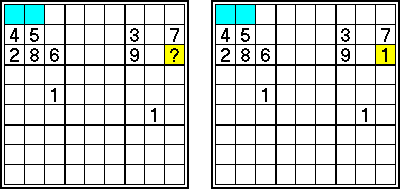Basic Sudoku Solving Techniques
Originally, only trivial techniques were used for solving Sudoku, but, as time went on, more and more difficult techniques have been developed for solving the puzzles. This page is interested in the baic techniques: the techniques that are simple to understand, and are the least advanced. You can get quite far in Sudoku by only knowing the basic techniques. If you find a puzzle that you cannot solve with these techniques, however, feel free to check out the more complex intermediate and advanced solving techniques.
Naked Singles (aka Force)
Take a look at this illustration, especially the highlighted number:
In general, if putting any value except a specific value X in a cell is an immediate contradiction (for example, putting 1 in the highlighted cell would cause its box to have two 1's, which is against the constraints), that cell must hold the value X. In this case, the cell must hold the value 8, because every other value is impossible.
Hidden Singles (aka Pin)
In a region, if none of the cells except a specific cell can hold the value X, that cell must hold X. Take a look at this illustration:
In this case, the yellow cell must be a 2, because no other cell in its box can hold a 2. Note, also, that this technique does not have to work with boxes; the cyan cell is the only cell in its row which can hold a 2, and so it must be a 2.
Subsets
Take a look at the illustration before I explain this:
If you analyze the upper-left box, exactly one of the cyan cells must have a value of 1, as those cells are the only places where a 1 can go. Since the cyan cells are both in the same row, no other cell in that row can have a 1, because it would then force neither of the cyan cells to have a 1 (which is impossible). So, if you look at the upper-right box, you can see that the only cell that can possibly have a 1 is the yellow cell.
Generally, if exactly one of a set of cells in a region must have a certain value, no other cells in that region can have that value.


